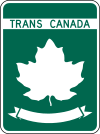Theodore Roosevelt International Highway
| |
|---|---|
| Route information | |
| Length: | 4,060 mi[1] (6,530 km) |
| Existed: | January 6, 1919[2] – 1930s[1] |
| Major junctions | |
| West end: | Portland, Oregon |
| East end: | Portland, Maine |
| Location | |
| States: | Oregon, Washington, Idaho, Montana, North Dakota, Minnesota, Wisconsin, Michigan, Ontario, New York, Vermont, New Hampshire, Maine |
| Highway system | |
|
Auto Trails | |
The Theodore Roosevelt International Highway was a transcontinental North American highway, from the era of the auto trails, through the United States and Canada that ran from Portland, Maine, to Portland, Oregon. Its length was about 4,060 miles (6,530 km).
Route description
The highway left Maine through the White Mountains of New Hampshire and the Green Mountains of Vermont to cross Lake Champlain by ferry into New York. The highway went through Ontario from Niagara Falls to Windsor and from Detroit through Michigan's Upper Peninsula to Duluth, Minnesota, and then through North Dakota and Montana. The highway passed through northern Idaho and Yakima, Washington, to follow the Columbia River into Oregon.[3] U.S. Route 2 (US 2) was numbered along similar routing through the United States in 1926, although neither Portland was included.[2] The eastern end of the Theodore Roosevelt International Highway was designated US 302 in 1935, and is still known locally as the Roosevelt Trail.[3]
In Michigan, the highway had a northern loop route in the Upper Peninsula. Between St. Ignace and Wakefield, the northern route followed what is now M-123 and M-28 while the southern route followed the rough path of today's US 2.[1]
History
The highway was designated as a memorial following Theodore Roosevelt's death on January 6, 1919.[2] Michigan completed its section of the highway in the middle of 1926.[1] A 56-mile (90 km) portion of the highway over the continental divide through Marias Pass in northwestern Montana was not completed until 1930. Automobiles were carried over the pass in Great Northern Railway cars until the highway was finished.[4] Dedication ceremonies for the full route were held in Montana four months after the completion of the highway. The name has fallen into disuse after the 1930s with the 1926 designation of the United States Numbered Highway System that replaced much of its routing with numbered highway designations.[1]
See also
 Canada Roads portal
Canada Roads portal U.S. Roads portal
U.S. Roads portal
 Michigan Highways portal
Michigan Highways portal.svg.png) New York Roads portal
New York Roads portal Washington Roads portal
Washington Roads portal
References
- 1 2 3 4 5 Barnett, LeRoy (2004). A Drive Down Memory Lane: The Named State and Federal Highways of Michigan. Allegan Forest, MI: Priscilla Press. pp. 211–2. ISBN 1-886167-24-9.
- 1 2 3 Weingroff, Richard (April 7, 2011). "US 2: Houlton, Maine, to Everett, Washington". Federal Highway Administration. Retrieved September 5, 2011.
- 1 2 Tracy, A.W. (December 1996) [1921]. "Highway Display's America's Glories". Theodore Roosevelt International Highway, Montana (PDF). Montana Department of Transportation. p. 7. Retrieved August 21, 2008.
- ↑ Rhode, Chuck (September 1, 2004). "Down the Yellowstone Trail". The Hi-Line and the Yellowstone Trail: To Glacier Park and Back Again. Lacus Veris. Retrieved September 14, 2011.
